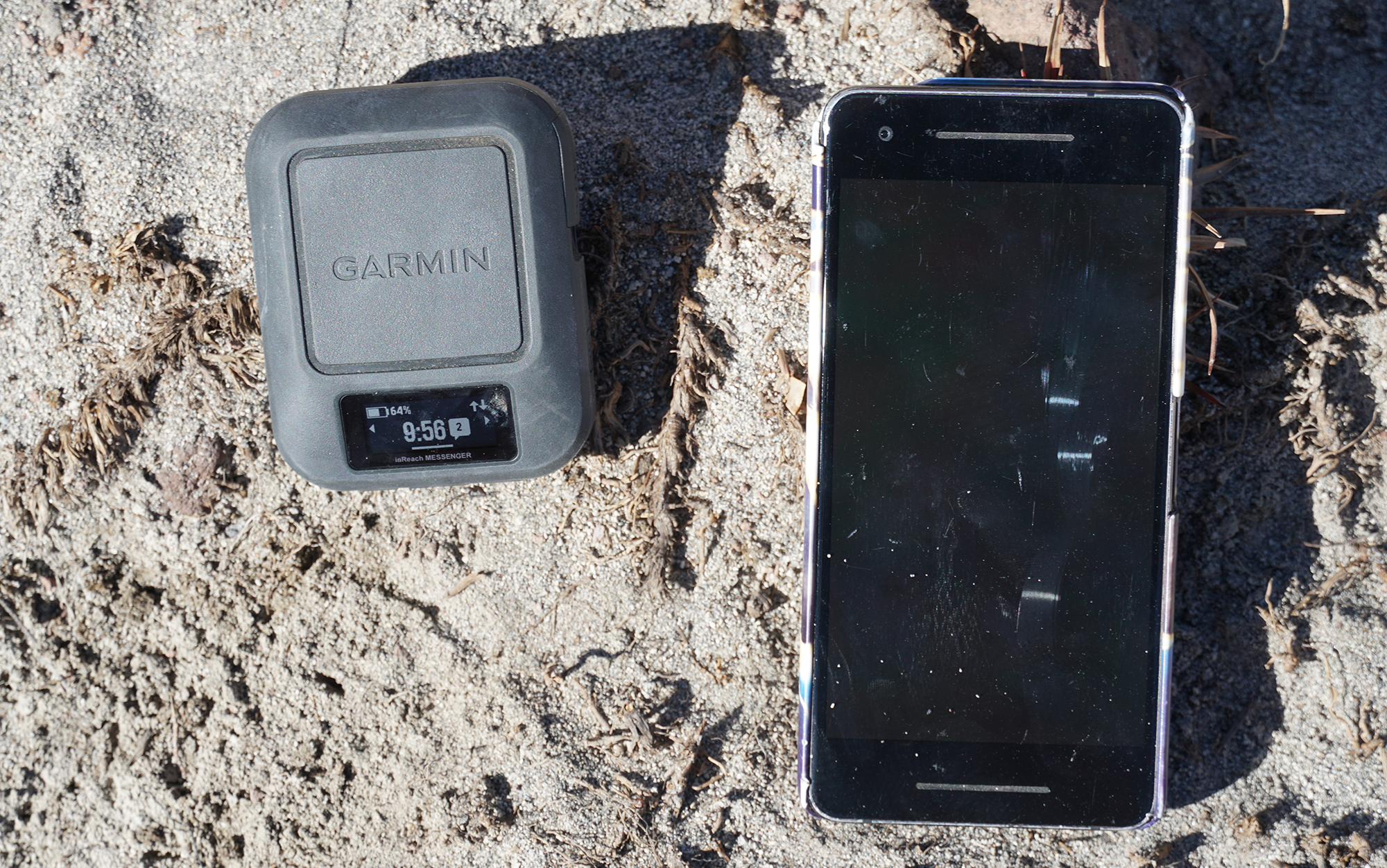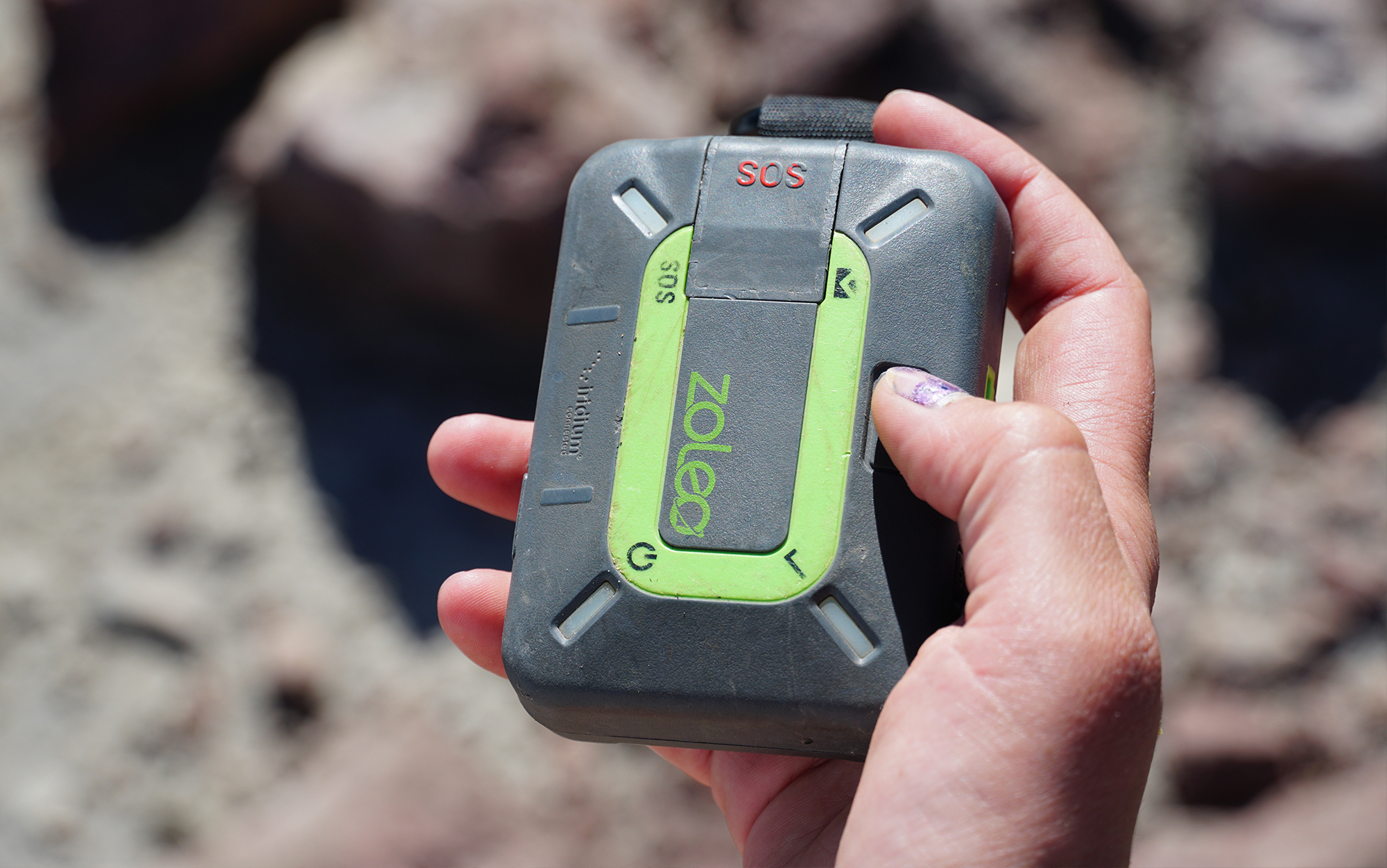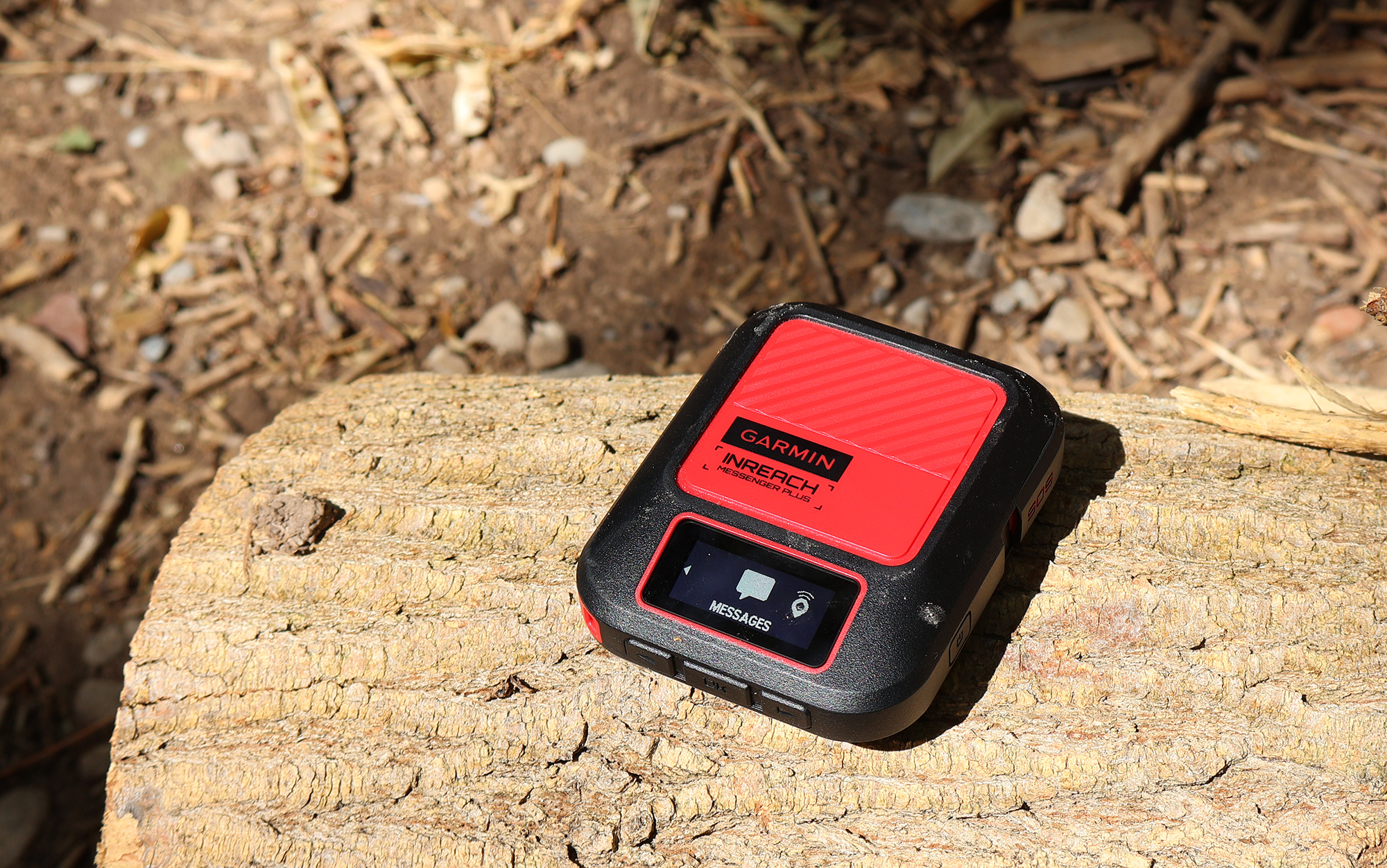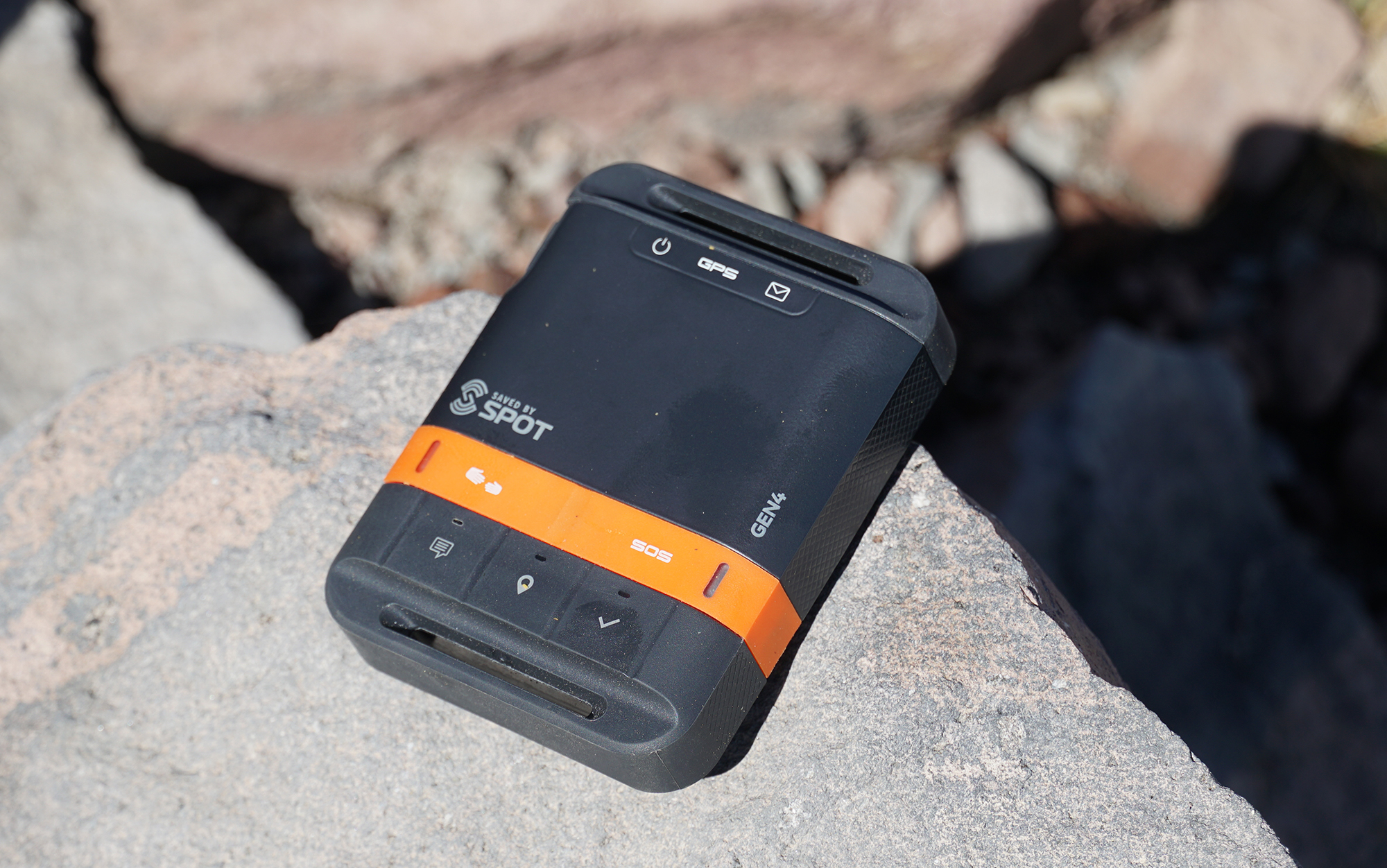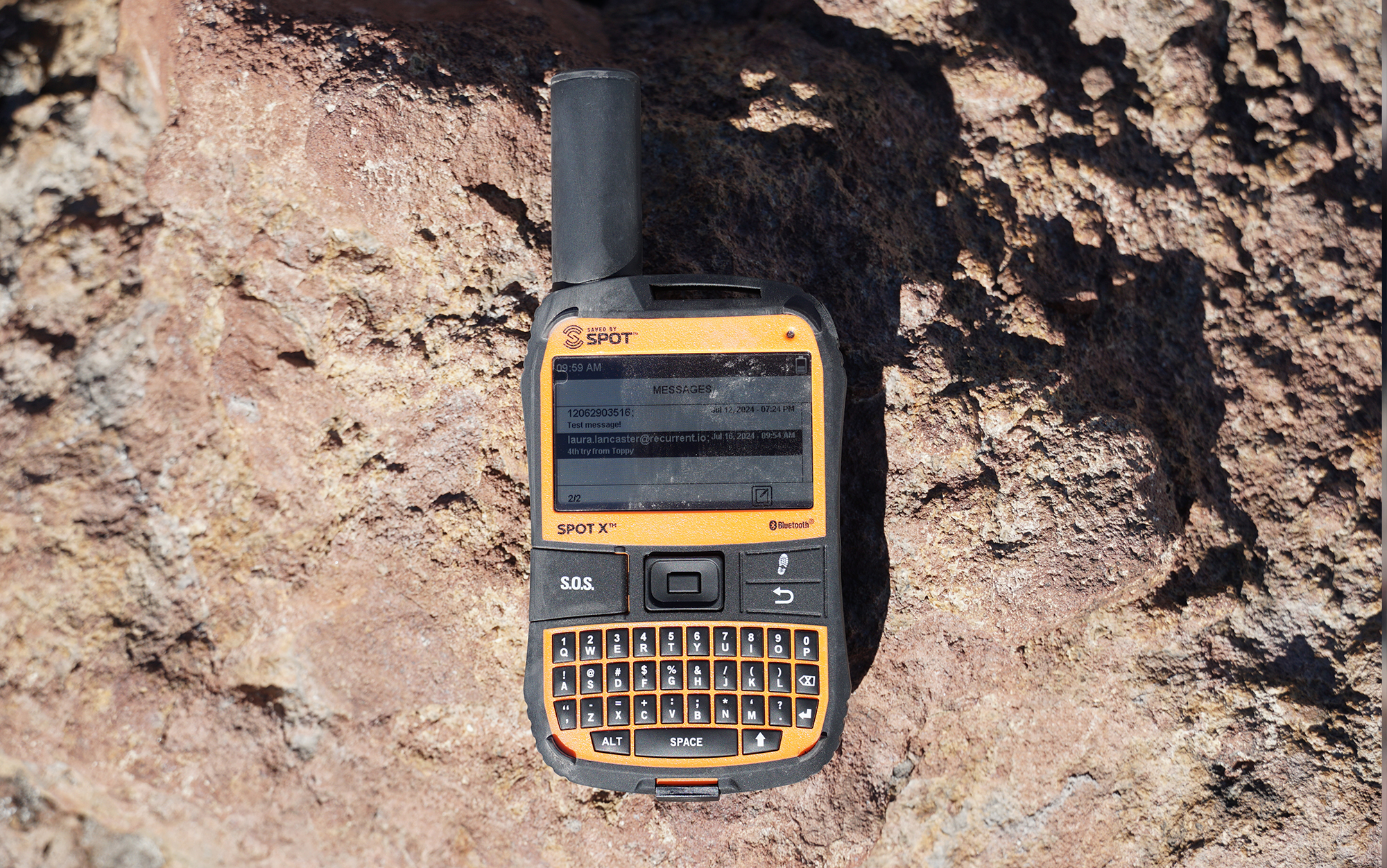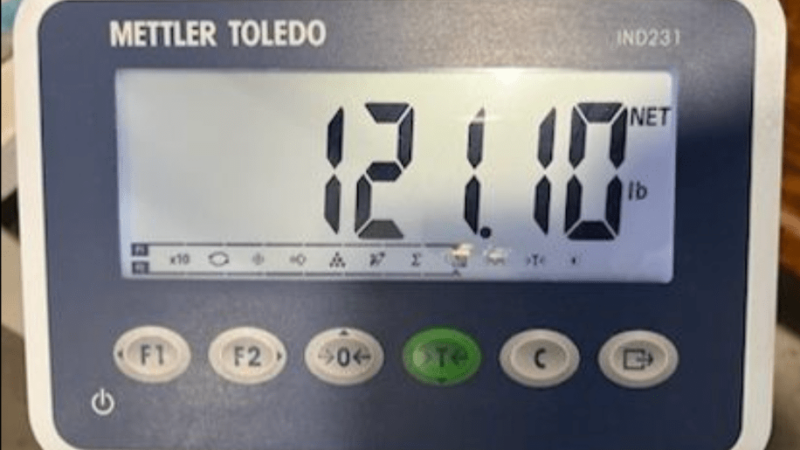The Best Satellite Messengers, Based on Field Testing
We may earn revenue from the products available on this page and participate in affiliate programs. Learn More ›
Satellite messengers can save your life. You want a unit with the best chance possible of contacting SOS services in the event of an emergency. But satellite messengers are also one of the most expensive items in a backcountry kit, with confusing subscription structures and extra fees. Over the course of a few years owning a satellite messenger, you’ll likely pay $1,000 or more in upfront and subscription fees. To help you choose the best satellite messenger for your needs, I field tested six different models and put together a side-by-side comparison of their fee structures.
To start, satellite messengers were put through a head-to-head test during Outdoor Life’s annual backpacking gear testing trip. This included testing the reliability of satellite messengers in sending messages, and paying attention to differences between the Globalstar and Iridium networks. You can read a full breakdown of our field testing protocol here. Next, I looked at the internal battery and weight of each unit. I considered both testers’ experience with the satellite messengers and tested specifications in house. Finally, I ran a price comparison across both a single year and five years of seasonal use for the best satellite messengers.
- Best Overall: Garmin inReach Messenger
- Best for Short-Term Use: Zoleo
- Best Ultralight: Garmin inReach Mini 2
- Garmin inReach Messenger+
- ACR Bivy
- SPOT Gen4
- SPOT X
Best Satellite Messengers: Reviews & Recommendations
Best Overall: Garmin inReach Messenger
Key Features
- Capable of sending SOS, tracking, check-in messages, and custom messages
- Satellite Network: Iridium
- Weight: 4 ounces
- Monthly plans range from $8 (SOS only) to $50 (unlimited custom messaging)
- Price: $300
Pros
- Uses Iridium network
- Fairly lightweight
- Excellent battery life
- Able to message without a paired phone
Cons
- Only comes in black
- No dedicated phone number
After going through all the data I had on price, reliability, and functionality, it’s clear that the Garmin Messenger is the best option for the vast majority of people. Like all Garmin products, it works off of the Iridium network, which testing showed outperforms the Globalstar network in reliably sending messages. While it’s middle of the road for pricing across all metrics, I appreciated that it had a lower monthly fee than the Zoleo and ACR satellite messengers, which helps when you inevitably realize that you forgot to deactivate. I especially appreciate their recent decision to allow for an SOS-only subscription, called Enabled, with the option to send custom messages or check-ins that you pay for on a per basis. This costs $8 a month, while their lowest priced plan that includes 50 custom messages costs only $15.
The Garmin Messenger has the most impressive battery of any satellite messenger we tested, and it wasn’t even close. While other testers were checking and re-upping their satellite messenger batteries during our testing trip, I left my testing unit on without upping the battery once. By the end of four days in the backcountry, the battery was at 86 percent. That translates to roughly 3.5 percent battery use per day which is on track for the Messenger to hit the claimed 28-day lifespan. And that’s with sending multiple messages over the course of a testing trip. (I did not, however, have location tracing enabled.)
The Garmin inReach Mini 2 has long been a favorite among backpackers for the ability to message directly from the device. However, this involves some serious henpecking to actually do. In practice, people use the app. But, the ability to send a message directly from the satellite messenger can be instrumental in the event that your phone is disabled and you need emergency assistance.
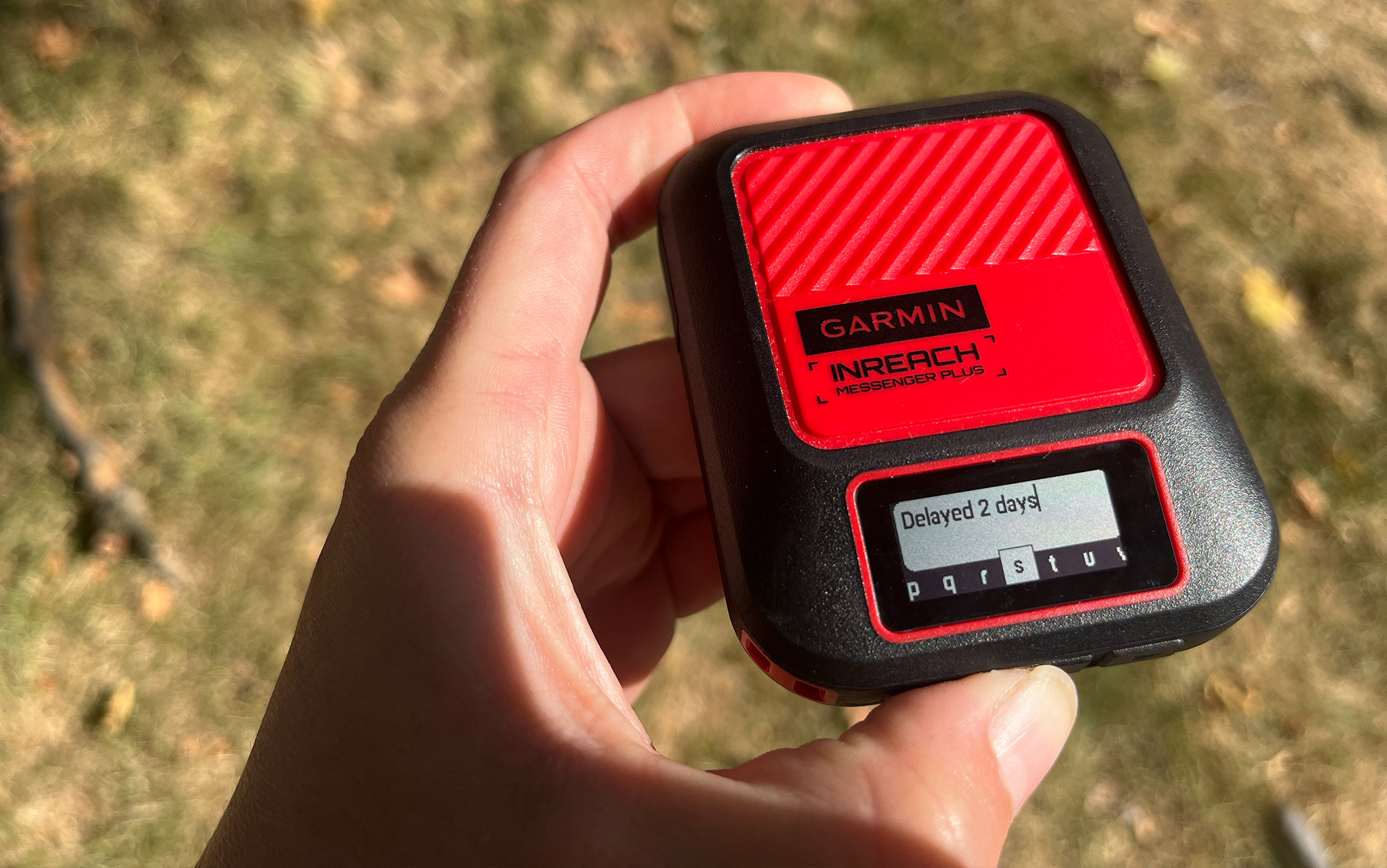
Ashley Thess
In my experience, the henpecking required to send a message through the noticeably smaller screen of the Messenger is slightly more annoying than with the Mini 2, but not enough so to override its main benefit compared to that more expensive unit.
A couple of minor dings. There is no option to suspend service with Garmin, only move it to the lowest tiered pricing structure. If you only plan to use your satellite messenger one week a year, this may not be the best option. That being said, having a satellite messenger available to you whenever you are off grid, including on remote roads or on one-off day hikes, is never a bad idea. I also don’t love the color: black. Because satellite messengers work best under clear skies, there will inevitably be times that you put the unit slightly away from where you’re setting up your tent. A brighter color (hot pink, anyone?) would help prevent backpackers and others from leaving it behind when they set up camp.
Best for Short-Term Use: Zoleo
Key Features
- Capable of sending SOS, tracking, check-in messages, and custom messages
- Satellite Network: Iridium
- Weight: 5.3 ounces
- Monthly plans range from $20 (25 custom messages) to $50 (unlimited custom messaging)
- Price: $200
Pros
- Low upfront cost
- Uses the Iridium network
- Dedicated phone number
Cons
- Slightly heavier than other satellite messengers
- Can’t send custom messages without a smartphone
- Less robust battery
Zoleo’s lower upfront cost has made it a popular choice with backpackers and, given the snowballing advances occurring in the smartphone-satellite space, that may make it a smart choice for someone who expects to use their smartphone as an all-in-one option in the not-to-distant future. Associate editor Ashley Thess sung the praise of her Zoleo, saying that she had used hers to “ask a friend how to scare off a rattlesnake, get quarterly updates on a football game, checked in with her emergency contact on trip delays, and send a happy birthday message.”
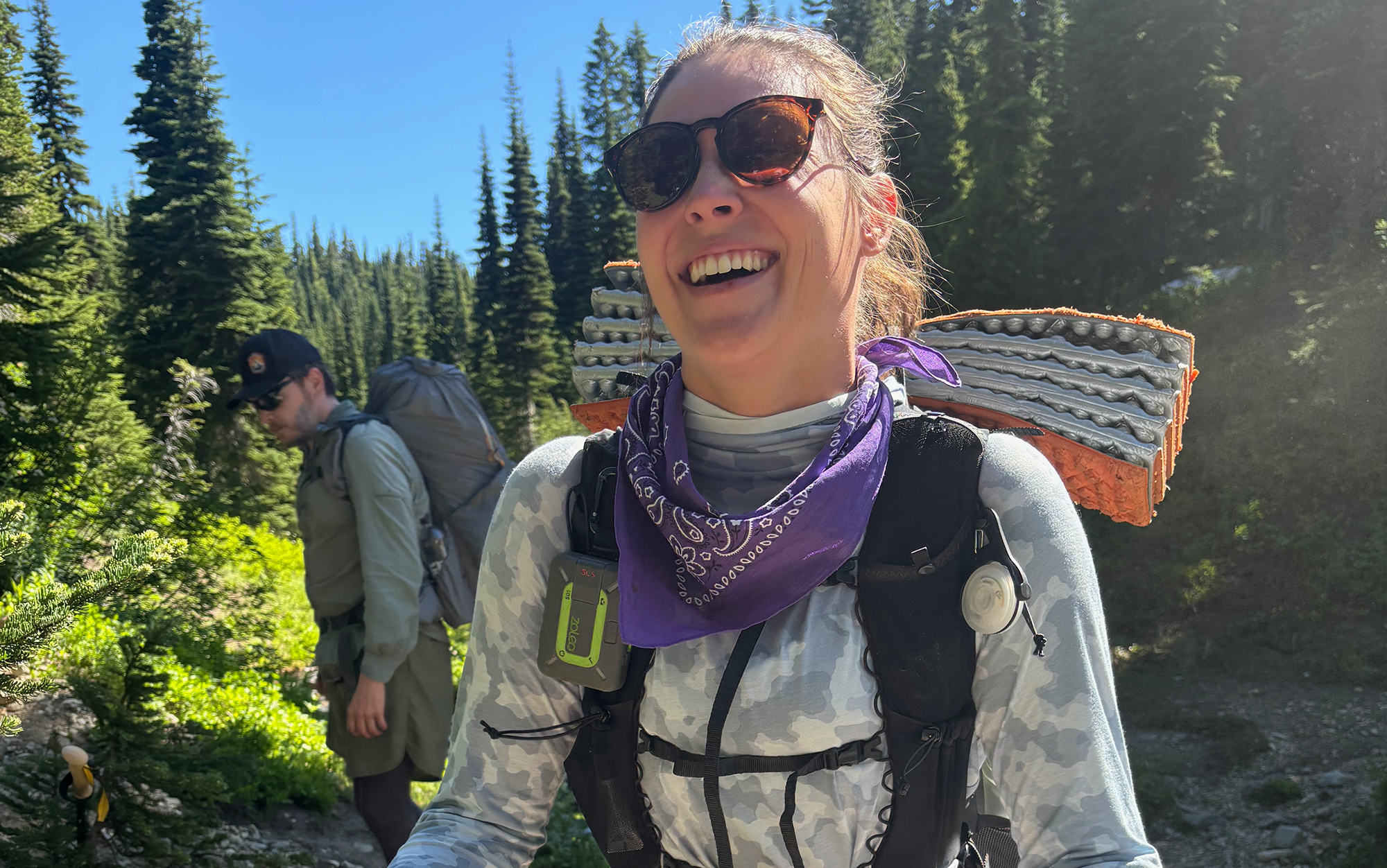
Diana Helmuth
There is a downside to the cost of the Zoleo on the back end, where it has a higher monthly subscription cost, $20 for 25 satellite messengers compared to the Garmin inReach’s $15 for 50 messages. And while you can hit the SOS button directly on the device itself, there is no way to type a message out without a smartphone bluetooth connection. Thess was also surprised that her Zoleo’s battery did not last for the duration of the trip, needing to be recharged after a single day of being left on. (You can prolong the battery life by turning it off when not in use or changing the interval of how often it checks for messages.) Finally, ultralight backpackers, take note: This one also weighs about an ounce more than our top pick and almost two ounces more than our best ultralight option.
Best Ultralight: Garmin inReach Mini 2
Key Features
- Capable of sending SOS, tracking, check-in messages, and custom messages
- Satellite Network: Iridium
- Weight: 3.5 ounces
- Monthly plans range from $8 (SOS only) to $50 (unlimited custom messaging)
- Price: $400
Pros
- Half an ounce lighter than my best overall pick
- Easier to text directly on the device
Cons
- Higher upfront cost
- Smaller battery than the Messenger
- Slightly slower messaging times than the Messenger
- No dedicated phone number
Despite having more features and a larger on-board screen, the Garmin inReach Mini 2 clocks in at a half an ounce lighter than the Messenger. But there is a cost to all that. A literal cost: The inReach Mini 2 is $100 more expensive. And also a functionality cost. Not only is the battery on the Mini 2 about half that of the Messenger, it also has a less robust antenna. During testing, the Mini 2’s messages always took slightly longer than the Messenger’s to send, with the worst differential being 15 minutes.
But if you’re going out for less than a week and plan to message on your satellite messenger exclusively (rather than pairing it via Bluetooth to an app on your phone) then this may indeed be the best option for you. The larger screen and autocomplete function does make it easier to message directly from the Mini 2 than the Garmin inReach Messenger.
Garmin inReach Messenger+
Key Features
- Capable of sending SOS, tracking, check-in messages, custom messages, voice memos, and photos
- Satellite Network: Iridium
- Weight: 4.1 ounces
- Monthly plans range from $8 (SOS only) to $50 (unlimited custom messaging, 50 photos/voice memos)
- Price: $500
Pros
- Can send photos
- Can send voice memos
- Can send longer text messages
Cons
- Expensive
While Outdoor Life wasn’t able to include Garmin’s new inReach Messenger+ on our testing trip, as it launched after we had returned to the frontcountry, associate editor Ashley Thess got out with the latest model to see how it compared to the competition. What sets this unit apart from all other satellite messengers is that it is able to share photos and voice memos while off grid.
Thess came away impressed with the ease with which she was able to share photos and send voicemails via the Messenger+. While testing will be ongoing to ensure it has the same reliability that we’ve come to expect from other Garmin products, if you’re looking for more robust communication with loved ones in the frontcountry, this is a solid pick. However, if you are only purchasing a satellite messenger for the purpose of SOS capabilities and being able to reassure loved ones in the frontcountry that you’re still alive, it’s not really necessary. Note that while the upfront cost is significantly higher than for the regular Messenger model, the subscription plans are priced the same.
Read Next: The New Garmin inReach Messenger Plus Sends Photos, Voice Memos, and Group Chats
ACR Bivy
Key Features
- Capable of sending SOS, tracking, check-in messages, and custom messages
- Satellite Network: Iridium
- Weight: 3.5 ounces (tested at 3.8 ounces)
- Monthly plans range from $20 (20 custom messages) to $60 (unlimited custom messaging)
- Price: $300
Pros
- Lightweight
- Rolling text message accrual
- Compatible with GoPro mounts
- Dedicated phone number
- Easy set up
Cons
- Less robust battery
- Sent our test messages to a spam folder
- Expensive in the long term
First, a disclaimer on this review. It took over a month for me to look at the results of my satellite messenger field test — too busy looking at the results of our test of the best backpacking tents, best backpacking backpacks, and others. Then, when I did, I had no messages in my inbox from the ACR Bivy we tested. Further trial messages revealed why: They were sent to my spam folder, where they were then deleted after a month. While this unfortunately makes it difficult to compare the speed of the ACR Bivy’s antenna against the likes of the Garmin Messenger, we can fortunately still infer some information since it uses the Iridium network, which performed better than the Globalstar network across the board.
While using the ACR Bivy means that you’ll want to ensure your contacts are regularly checking their spam folders, this unit did have some advantages over the others. If you’re sending text messages instead of emails, the ACR Bivy has a dedicated phone number that your contacts can add to their phone. It’s fairly lightweight, if not quite as light as advertised (my unit clocks in at 3.8 ounces), and can be mounted using the same hardware as a GoPro, which is very handy for those of us prone to misplacing smaller items. I also appreciated that this one was comparatively fast to set up.
Unfortunately, the minimum subscription fee for this makes it a pretty pricey unit to own long-term. That being said, unused text messages roll forward, month to month, which may help mitigate the costs for less frequent, more connected users.
SPOT Gen4
Key Features
- Capable of sending SOS and pre-set messages only
- Satellite Network: Globalstar
- Weight: 5 ounces
- Monthly plan is $15
- Price: $150
Pros
- Low upfront cost
Cons
- Missed a check-in
- High per month fee for the service provided
- Heavier than other options we looked at
- No two-way messaging (may be considered a pro by some)
As satellite messengers get better and better, the whole idea of being “off grid” seems to be at risk. Photos? Voice memos? Group chats? What’s next, Slack? For those of us that prefer our tech a little less advanced, the SPOT Gen4 has exactly what you need and nothing more. This one has an SOS button, a tracking button, a check-in button, and a second message button that you can customize in advance. That’s it. There is no way to type out a customized message in the field; no way for someone to get in contact with you. This is especially nice if you have someone in the frontcountry who is worried about you but you don’t necessarily want to be hearing from them on the regular.
As a Luddite myself, I love the idea of the SPOT Gen4 (I even used an older version of this back in 2014 on my PCT hike). Unfortunately, I can’t give it a full-throated recommendation for a couple of reasons. The first is the cost. While this has a low upfront fee, the subscription cost is on par with other satellite messengers, even a little higher in some cases. This just doesn’t make sense given the reduced functionality. But the bigger issue is that in testing, both the SPOT Gen4 and the SPOT X missed the same check-in.
Both users received confirmation that their message had gone out on the SPOT devices they were in charge of, but when I checked the log back in the frontcountry, they were missing. I don’t love that the SPOT was unable to send a message at all, but the bigger issue here is that it indicated it had sent a message when it had not. It’s worth noting that both the SPOT Gen4 and SPOT X use the Globalstar satellite network, which is also the satellite network enabling SOS functionality on iPhone models 14 and higher.
SPOT X
Key Features
- Capable of sending SOS, tracking, check-in messages, and custom messages
- Satellite Network: Globalstar
- Weight: 7 ounces
- Monthly plans range from $15 (15 custom messages) to $40 (unlimited custom messaging)
- Price: $250
Pros
- Low price for the features
- Built-in keyboard
Cons
- Missed a check-in
- Heavier than other options we looked at
The SPOT X is the only satellite messenger we looked at with a built-in keyboard. That means that even if your phone died on you in the field, you could still use the SPOT X to customize messages to loved ones or emergency personnel without the henpecking required by the Garmin inReach options. And it provides all of this at the same pricing structure as for the SPOT Gen4. In my opinion, the SPOT Gen4’s subscription plan is overpriced, but the SPOT X’s is a much better deal.
Unfortunately, as detailed above, missing a check-in could be a big issue for backcountry travelers, and does not inspire confidence in the SOS feature.
Satellite Messengers vs Smartphones: Emerging Off-Grid Communication Technologies
Over the last two years, it’s become clear that the SOS function on Apple’s iPhone 14 and 15 is a gamechanger for the backcountry. Individuals who previously might not have carried a dedicated satellite messenger are now able to use their iPhone to ping the orbiting Globalstar satellite network for help in the event they’re lost or injured out of service. More recently, Apple has added two-way communication. So if you have an iPhone 14 or higher, do you even still need a dedicated satellite messenger?
There are a few reasons that you should still carry a dedicated satellite messenger, at least for now. The biggest one is that Apple’s iPhone is using the Globalstar network, which our testing showed is still plagued by reliability issues. And while iPhone is now capable of sending both SOS signals and texts via iMessage, there are some limitations. The first is that this functionality is only available with iPhone 14 or more recent models. The second is that, to text, both parties will need the iPhone 14 or higher. With other satellite messengers, your contact in the frontcountry can text you back or send an email from any device, not just one equipped with satellite messaging.
But, that Apple already has this functionality up and running is impressive. And they aren’t the only ones. Garmin announced a deal with Google to provide SOS capability on Pixel 9s. Finally, Starlink in partnership with T-Mobile is launching satellites that can be used for texting and, at some point, cellular calls and data use.
While I do not see any one of these updates as spelling the end of dedicated satellite messengers any time soon, cumulatively these product upgrades are trending toward a future where they may very well become obsolete for many. Outdoor Life will continue to monitor these developments, including side-by-side testing of these features as they become available to better understand their functionality and reliability.
How We Tested the Best Satellite Messengers
Satellite messengers were evaluated on a number of metrics, including functionality, pricing models, in-house measurements, and field testing.
Field Testing Satellite Messengers
Satellite messengers were included as part of our testing protocol on the 2024 Outdoor Life backpacking gear test along the Goat Rocks Wilderness section of the Pacific Crest Trail. Members of the testing crew were each assigned a satellite messenger to test. Each day, at the same time and in the same place, we all sent a message to my email. While using the satellite messengers, users noted battery lifespan and functionality issues.
Below I’ve laid out the days and times of our check-ins. Times reflect the timestamp in my inbox in the frontcountry, while parenthetical times reflect the time that the satellite messengers indicated they were sent. The ACR Bivy check-in’s unfortunately were sent to my spam folder and subsequently deleted, so there is no record for those messages at this time.
| Testing Day | Garmin inReach Messenger | Zoleo | Garmin inReach Mini 2 | ACR Bivy | SPOT Gen4 | SPOT X |
| AM Day 1 (Walupt Campground) | 8:27 a.m.(8:23 a.m.) | 8:36 a.m. (8:22 a.m.) | N/A | Unavailable | Missed | Missed |
| PM Day 1 (Cispus Basin) | 7:49 p.m.(7:42 p.m.) | 7:49 p.m.(7:42 p.m.) | N/A | Unavailable | 7:45 p.m. | 7:43 p.m. |
| PM Day 2 (Snowgrass Flats) | 6:20 p.m.(6:20 p.m.) | 6:21 p.m.(6:21 p.m.) | 6:26 p.m. (6:20 p.m.) | Unavailable | 6:22 p.m. | 6:21 p.m. |
| AM Day 3 (Knife’s Edge) | 9:55 a.m.(9:55 a.m.) | 9:55 a.m. (9:54 a.m.) | 9:55 a.m. (9:54 a.m.) | Unavailable | 9:58 a.m. | 9:55 a.m. |
| PM Day 3 (Pond in the Woods) | 8:43 p.m.(8:40 p.m.) | 8:36 p.m. (8:35 p.m.) | 8:43 p.m. (8:28 p.m.) | Unavailable | 8:28 p.m. | 8:51 p.m. |
Editor-in-chief Alex Robinson and I were also able to test out Garmin’s device to device service. Rather than join us at the start of the backpacking trek, Robinson met us halfway through, using a side trail to intersect our location on the Pacific Crest Trail. I confirmed timing with him using the Garmin inReach Mini 2 and Garmin inReach Messenger while we were both off grid. Two members of our testing team were waiting for him at the intersection minutes before he hiked up the trail.
Messaging Capabilities
All satellite messengers offer different messaging options. Here is an overview of what each offers so you can ensure you are picking the option that meets your needs.
| Satellite Messengers | SOS | Pre-Set Messages | Tracking | Custom Messages | Voicemails | Photos |
| Garmin inReach Messenger | Yes | Yes | Yes | Yes | No | No |
| Zoleo | Yes | Yes | Yes | Yes | No | No |
| Garmin inReach Mini 2 | Yes | Yes | Yes | Yes | No | No |
| Garmin inReach Messenger+ | Yes | Yes | Yes | Yes | Yes | Yes |
| ACR Bivy | Yes | Yes | Yes | Yes | No | No |
| SPOT Gen4 | Yes | Yes | Yes | No | No | No |
| SPOT X | Yes | Yes | Yes | Yes | No | No |
Weight and Battery Lifespan
I weighed each satellite messenger and noted how the claimed battery life performed in the field, where tree cover and canyons can have a massive impact on battery lifespan. Keep in mind that the harder it is to connect to a satellite, and the more messages you send, the less time your battery will last.
| Satellite Messenger | Claimed Weight | Tested Weight | Claimed Battery Life | Need to Recharge while Testing? | IP Rating |
| Garmin inReach Messenger | 4 ounces | 4 ounces | 28 days | No | IPX7 |
| Zoleo | 5.3 ounces | 5.3 ounces | 200 hours | Yes | IP68 |
| Garmin inReach Mini 2 | 3.5 ounces | 3.5 ounces | 14 days | No | IPX7 |
| Garmin inReach Messenger+ | 4.1 ounces | 4.1 ounces | 25 days | N/A | IPX7 |
| ACR Bivy | 3.5 ounces | 3.8 ounces | 120 hours | No | IPX7 |
| SPOT Gen4 | 5 ounces | 5 ounces | N/A | No | IPX8 |
| SPOT X | 7 ounces | 6.9 ounces | 240 hours | No | IPX7 |
Price Comparison
With satellite messengers, the upfront cost is just the start. Next there is the activation fee. Then you have to choose between a monthly subscription or a yearly subscription plan — watch out for hidden fees like reactivation charges. It was such a mess to sort through that I ended up putting together an Excel spreadsheet filled with formulas.
The below table breaks down the costs, and compares the price for a season’s worth of service for one year versus a season’s worth of service for five years. I also included notes on one-time activation fees (paid when you start up your subscription) and reactivation fees when you restart a subscription that was suspended
| Satellite Messenger | Total Price for 3 Months | Total Price for 1 Year | Total Price for 3 Months for 5 Years | Total Price for 5 Years | Unit Cost | One time Activation Fee | Reactivation Fee | Annual Flex Charge | Price per Month | Price for a Year |
| Garmin inReach Messenger | $457 | $484 | $915 | $1,060 | $300 | $40 | None | None | $15* | $180 |
| Zoleo | $316 | $460 | $700 | $1,420 | $200 | $20 | None | None | $20 ($4 for suspended plans) | N/A |
| Garmin inReach Mini 2 | $557 | $584 | $1,025 | $1,160 | $400 | $40 | None | None | $15* | $180 |
| Garmin inReach Messenger+ | $657 | $684 | $1,125 | $1,260 | $500 | $40 | None | None | $15* | $180 |
| SPOT Gen4 | $260 | $324 | $580 | $900 | $150 | $30 | None | $35 (only for monthly plans) | $15 | $144 |
| SPOT X | $360 | $424 | $680 | $1,000 | $250 | $30 | None | $35 (only for monthly plans) | $15 | $144 |
| ACR Bivy | $390 | $510 | $750 | $1,230 | $300 | $30 | $30 | None | $20 | $180 |
Things to Consider Before Purchasing a Satellite Messenger
Satellite Network
There are two private satellite networks that satellite messengers use: Iridium and Globalstar. Backpackers and others have long felt that the Iridium network was more reliable, and that devices on the Globalstar network will indicate that messages have been sent that are then never received in the frontcountry. Our testing confirmed that this is still the case.
The other two satellite networks to be aware of are Cospas-Sarsat and Starlink. The former uses a collection of satellites from various government agencies around the world. While this network has long been heralded as the most accurate, you can only use SOS on it. As such, most satellite messengers have moved to Iridium or Globalstar. More recently, Starlink has moved into this space. While their satellites have to date not been compatible with cell phones or other satellite messengers, they are working to change that.
Battery Life
A satellite messenger with a dead battery isn’t going to save anyone’s life. And while most backpackers now carry power banks, a reliable, long-lasting battery will at a minimum provide you peace of mind in the backcountry, and could even save your life. Another consideration is that the batteries in satellite messengers will slowly leak power over time, even turned off in storage. If you haven’t upped the charge on your satellite messenger in some time, there is a chance that the battery has completely died. And if the battery is completely depleted for too long, it will eventually not be able to hold a charge.
Buy What Your Friends Have
Typically I wouldn’t advocate for following the crowd, but in this instance, there is a good reason. That’s because if you have a Garmin satellite messenger and your friends have Garmin satellite messengers, you can use them to communicate with one another while in the backcountry. That’s huge in the event you are separated. Same with SPOT. And Zoleo. And ACR. But, you have to have the same brand of device for this to work.
Messaging Capabilities
How much messaging capability you need depends largely on your personal circumstances and preferences. Some people like to stay in close contact with friends and loved ones in the backcountry; others prefer the solitude. If you plan to stay in regular communication, look for a plan that has a great value for unlimited messages. You may also want to consider opting for a satellite messenger that allows you to compose a text directly on the device.
FAQs
Satellite-enabled SOS services in the backcountry have saved countless lives, and it’s absolutely something you should invest in if you are traveling off grid, particularly if you are headed somewhere remote where you don’t expect to encounter many people. However, with the rise of satellite-enabled SOS abilities on smartphones — already iPhone 14s have this capability with Google’s Pixel and T-Mobile set to follow — individuals who are heading out for shorter stints into the backcountry may choose, in some situations, to forgo dedicated satellite messengers.
However, keep in mind that the backcountry is still the backcountry. In a best case scenario, you could be waiting hours or even a full day for emergency personnel to reach your location. And it isn’t always the case that there is a helicopter at the ready to evacuate. More often than not, you’ll have to participate in your own evacuation. Finally, the vast majority of search and rescues are handled by volunteers: take their time and safety seriously by avoiding unnecessarily risky situations.
While both Zoleo and inReach Messenger are excellent and lightweight satellite messengers that are on the Iridium network, there are a few important differences to be aware of. One of these is battery life: The Messenger has a much more robust, longer-lasting battery than the Zoleo. The next is price. The Garmin Messenger has a higher upfront price than the Zoleo, but all this pales in comparison to the subscription prices.
The Zoleo costs $20 a month for its lowest priced plan, which includes 25 custom messages and SOS functionality. Suspending service costs $4 if you don’t want to cancel. The lowest cost Garmin inReach plan costs only $8 a month. With that you get SOS capabilities and the ability to pay for text messages on a one-off basis. It’s $0.50 for custom text messages, $0.10 for check-ins, and $1 for the weather. Their next plan is $15 a month and includes 50 custom text messages. However, there is no option to suspend the plan. Ultralight enthusiasts should also note that the Zoleo is about an ounce heavier than the Garmin inReach Messenger.
Yes, you need an active subscription to use the SOS and other messaging functionalities of all satellite messengers. Always check that your satellite messenger is ready and working before heading off-grid.
Final Thoughts on the Best Satellite Messengers
A satellite messenger is a potentially life-saving piece of gear. Whichever one you choose, make sure you have an active subscription and fully charged battery before heading into the backcountry.
- Best Overall: Garmin inReach Messenger
- Best for Short-Term Use: Zoleo
- Best Ultralight: Garmin inReach Mini 2
- Garmin inReach Messenger+
- ACR Bivy
- SPOT Gen4
- SPOT X
The post The Best Satellite Messengers, Based on Field Testing appeared first on Outdoor Life.
Source: https://www.outdoorlife.com/gear/best-satellite-messengers/

